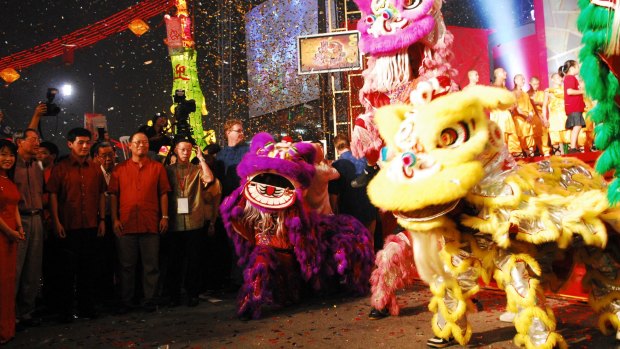This was published 7 years ago
Chinatowns in Asian cities: Six of the best
YOKOHAMA, JAPAN
Yokohama's Chinatown, Japan's largest, is more kitsch than cultural but has a raucous, colourful appeal. It's a popular destination for hungry visitors from Tokyo, just 30 kilometres away, and as a result is crammed with an estimated 600 eateries, from stalls selling steamed buns to noodle shops and grand banqueting halls draped in gold-leaf dragons. Souvenir stores spruik cheap, imported Chinese toys, fashions and chopstick sets, along with more upmarket jade and handicrafts. Amid the hubbub is ornate, 1873 Kantei-byo Shrine, dedicated to the god of prosperity and prettily illuminated in the evening with strings of overhead lanterns. See yokohamajapan.com.
HO CHI MINH CITY

Asia's Chinatowns are a riot of colour and sound during festivities.
Cholon or District 5 isn't so much a Chinatown, but it has a city neighbourhood whose majority population is Vietnamese-Chinese. With its quiet back alleys, small businesses, jade shops and incense-smoky temples, it provides a pleasing contrast to the French-influenced city centre. The most atmospheric temple is the 1818 Quan Am Pagoda, dedicated to the goddess of mercy, where a stream of visitors leave fruit offerings and burn paper money as resident monks snooze in corners. A small Catholic cathedral provides a curious contrast. Rambling Binh Tay Market offers everything from kitchenware and clothing to steaming bowls of pho. See vietnamtourism.com.
KUALA LUMPUR
This shabby Chinatown doesn't come off well when contrasted with other KL districts of sprouting skyscrapers and redevelopments, but what you get is a good, old-fashioned Chinatown of cramped street eateries where woks flare, traditional medicine stores piled with twisted roots and bark, and grungy junk markets. At night, Petaling Street erupts with a magnificently cramped tourist market of knock-off fashions, sunglasses and suitcases. A few 19th-century shophouses remain, along with Guandi Temple, decorated in bearded sages and mythological creatures. It's across the road from the incongruous Sri Maha Mariamman Temple, studded with blue-faced Hindu gods. See visitkl.gov.my.
MANILA
Across the Pasig River from downtown Manila lies Binondo district, noted for its street markets and Chinatown, which is probably the world's oldest, having been designated for Chinese immigrants in 1594. Its two cathedrals are a legacy of the colonial Spanish determination to catholicise its population. It lacks major sights but has a pleasing array of temples, ornate clan houses, martial-arts schools and teahouses. Chinatown is a great place for dining, with bargain restaurants lining Carvajal Street dishing up a fusion range of empanadas, dumplings, hopia pastries stuffed with bean paste and lumpia rolls, the Filipino version of spring rolls. See visitmyphilippines.com.
BANGKOK
In the early 18th century, Chinese immigrants moved into Sampeng district – now Bangkok's Chinatown – and rapidly assimilated. Unusually, few residents speak Chinese, but this Yaowarat Road area still has a distinctive character, with rickety shophouses and high-energy markets. Dragon Flower Temple sports ceramic roof dragons and an elegant gateway. A small museum at Wat Traimit explores Chinese immigrant history. Bargain textiles, leather goods and jewellery can be found at Soi Sampeng and Pahuraht Market, where half-price discounts are suddenly announced, creating a bargain-hunter's frenzy. Thieves Market sells second-hand furniture, books and electronics. Weekdays provide the best energy. See tourismthailand.org.
SINGAPORE
Singapore's Chinatown draws locals and visitors alike to its eateries (Smith Street is often referred to as Food Street) and several no-frills shopping complexes devoted to bargain-priced goods and handicrafts. The top sight is Thian Hok Keng Temple, where guardian figures with scimitars scowl, and incense burners throw shadowy light onto carvings and sculptures. Visitors place lit cigarettes into the hands of the Gambling Brothers statues, hoping for lottery luck. Unusually, Chinatown also has a Hindu temple, mosque and gold-laden Buddhist temple opened in 2007. As evening falls, hit the chic bars and nightclubs of Chinatown's redeveloped Tanjong Pagar area. See yoursingapore.com.
Brian Johnston travelled at his own expense.
Sign up for the Traveller Deals newsletter
Get exclusive travel deals delivered straight to your inbox. Sign up now.